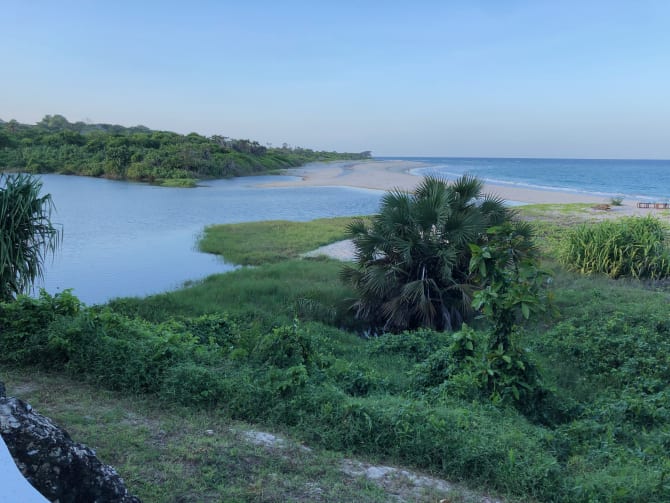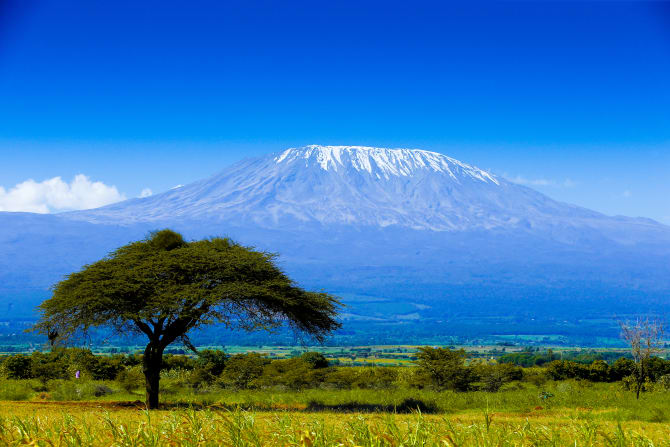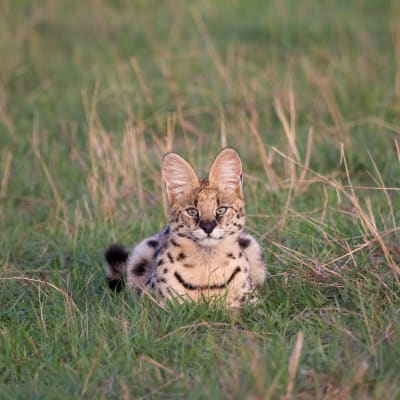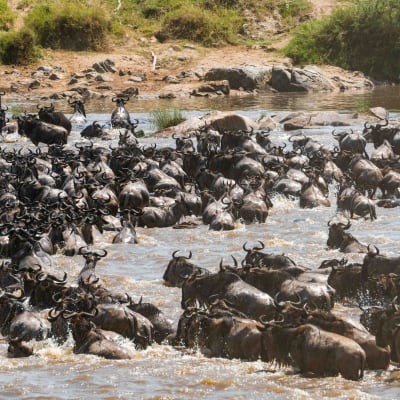
Best Travel Time for Tanzania
Climate, Weather, and Tips for Your Tanzania Trip
Climate, Weather, and Tips for Your Tanzania Trip
Do you dream of endless savannahs, majestic wildlife, and breathtaking sunsets over Kilimanjaro? Tanzania offers all this and much more. But when is actually the best time to visit this fascinating country? In our article, you will learn all about the optimal travel times for Tanzania – whether you are planning a safari in the Serengeti, exploring the Ngorongoro Crater, or enjoying the paradise beaches of Zanzibar. Let our tips and experiences inspire you and plan your dream trip to Tanzania. Discover the best times for unforgettable experiences and get ready to experience the wild beauty of Africa! Read on and find out when you should pack your bags.
Seasons and Climate in Tanzania
Tanzaniais located in East Africa, right on the equator, and therefore offers a pleasantly warm climate throughout the year. In principle, Tanzania can be traveled all year round. However, despite the constant temperatures, there are seasonal differences that can influence your travel experience. Unlike Central Europe, the annual cycle does not follow the four classic seasons. Instead, the dry season and the rainy season determine when which destinations are best to visit.
Dry Seasons
June to October (long dry season)
The months of June to October are considered the long dry season and are particularly popular with travelers. During this time, the days are sunny, and the temperatures are pleasantly warm, usually between 25 and 30 degrees Celsius. Nights can become cooler, especially in higher altitudes like the Ngorongoro Crateror on Kilimanjaro.
Advantages:
- Perfect conditions for safaris: Since the water sources in the national parks are limited, animals gather near the remaining waterholes, making wildlife observation easier.
- Lower mosquito plague: The dry season reduces the number of mosquitoes, lowering the risk of malaria.
- Ideal for hiking: Best conditions for climbing Kilimanjaro and other trekking adventures.
January to February (short dry season)
The short dry season in January and February is also a good time to travel. Although it is not as dry as the long dry season, these months still offer good conditions for safaris and beach holidays.
Advantages:
- Newborn animals: In many national parks, you can now observe numerous animal babies, which is particularly interesting for photographers.
- Pleasant temperatures: Similar to the long dry season, temperatures are warm and rainfall is minimal.
Rainy Seasons
March to May (long rainy season)
The long rainy season from March to May brings heavy and sustained rainfall. These months are less ideal for a trip as many roads become impassable, and some lodges close.
Disadvantages:
- Difficult road conditions: Muddy paths and flooded roads can make transportation difficult.
- Lower visibility of animals: The lush vegetation and increased water sources spread the animals over larger areas.
November to December (short rainy season)
The short rainy season from November to December is less intense than the long rainy season. It often features short, heavy downpours followed by sunny periods.
Advantages:
- Fewer tourists: Fewer travelers mean quieter parks and beaches.
- Green landscapes: The landscape shines in lush green, which is particularly appealing for photographers.
- Lower prices
Tanzania: Best Travel Time by Regions
Tanzania offers an incredible variety of experiences that vary from region to region. To align your trip perfectly with your interests, it is important to know the best travel time for the respective regions. Whether you want to visit the legendary national parks, majestic mountains, or paradise coasts - the following overview will help you keep track of when and where it's most beautiful:
Northern Tanzania: Serengeti, Ngorongoro Crater, Tarangire, Manyara
Best Travel Time: June to October
The national parks in northern Tanzania, such as the Serengeti, the Ngorongoro Crater, the Tarangire National Park, and the Manyara National Park, are best visited during the long dry season from June to October. These months offer excellent conditions for safaris as the animals gather at the few remaining waterholes, and the vegetation is less dense, making it easier to see the animals.
Advantages:
- Great animal migration: The famous Great Migration of wildebeests and zebras in the Serengeti takes place during this time.
- High animal concentration: In Ngorongoro Crater and Tarangire National Park, many animals are gathered in close quarters.
- Pleasant temperatures: Warm, dry weather provides comfortable conditions for safaris and hikes.
| Climate Table Serengeti | Jan | Feb | Mar | Apr | May | Jun | Jul | Aug | Sep | Oct | Nov | Dec |
|---|---|---|---|---|---|---|---|---|---|---|---|---|
| Average Day Temperature (°C) | 28 | 29 | 28 | 26 | 25 | 25 | 24 | 25 | 27 | 28 | 28 | 28 |
| Average Night Temperature (°C) | 15 | 15 | 16 | 16 | 15 | 14 | 13 | 13 | 14 | 15 | 16 | 15 |
| Sun Hours per Day | 8 | 8 | 7 | 6 | 7 | 8 | 8 | 8 | 8 | 8 | 7 | 7 |
| Rainy days per month | 5 | 5 | 9 | 16 | 10 | 3 | 3 | 3 | 3 | 5 | 8 | 7 |
Kilimanjaro and Northern Highlands (Arusha, Mount Meru)
Best travel time: January to March and June to October
As the highest mountain on the African continent, Kilimanjaro boasts an impressive altitude of 5,895 meters. Various vegetation zones range from the rainforests at the foot of the mountain to the icy glacier peak. The trade winds from the Indian Ocean also have a strong influence on the mountain climate. The best months for hiking on Kilimanjaro are January and February as well as June to October. Typically, it is dry and clear during this time. Snow and sub-zero temperatures prevail above the tree line from December to May.
Advantages:
- Clear sky: Better visibility of the peaks and breathtaking sunrises.
- Dry paths: Eases trekking and reduces the risk of slipping.
Southern Tanzania: Nyerere and Ruaha
Best travel time: June to October
The lesser-visited but equally impressive national parks in southern Tanzania, such as Nyerere National Park (formerly Selous Game Reserve) and Ruaha National Park, are also best visited during the long dry season from June to October. These months offer optimal conditions for wildlife observation and hiking.
Advantages:
- Low visitor numbers: Quieter parks with fewer tourists, allowing for a more exclusive experience.
- Excellent wildlife sightings: Animals are concentrated at the remaining water sources, making spotting them easier.
Western Tanzania: Mahale, Gombe, Katavi
Best travel time: June to October
The remote and wild regions in western Tanzania, such as the Mahale Mountains, Gombe, and Katavi National Park, are best visited during the long dry season from June to October. These months offer the best conditions for chimpanzee trekking and safaris.
Advantages:
- Chimpanzee trekking: Best conditions for observing chimpanzees in Mahale and Gombe.
- Untouched nature: Less-visited parks offer an authentic and pristine wilderness experience.
East Coast and Islands: Dar es Salaam, Zanzibar, Pemba, Mafia
Best travel time: June to October and January to February
The coastal regions and islands like Zanzibar, Pemba, and Mafia offer dream beaches year-round. However, the best time for a beach holiday is during the dry seasons from June to October and the short dry season from January to February. Right at the beginning of the year, hot temperatures above 30 degrees Celsius and numerous hours of sunshine allure visitors. Particularly convenient: The European winter and summer holidays fall within this timeframe. Take advantage of the opportunity and treat yourself to an island getaway under the palm trees.
Advantages:
- Clear water: Ideal for diving and snorkeling, as visibility underwater is excellent.
- Sunny days: Perfect for relaxing beach days and cultural explorations in the coastal towns.
Popular activities and their optimal travel times
Do you want to go on game drives in search of the Big Five, conquer Kilimanjaro, or dive off the coast of Zanzibar? Here are your recommendations for Tanzania – travel times based on the most popular activities:
Safari and wildlife observation
The best travel time for Tanzania safaris in the northern part of the country is the dry season in the southern winter. During this time, wildlife gathers in significant numbers on the Serengeti plains for the Great Migration. This ensures optimal visibility of big cats and elephants, buffalo, rhinos, and antelopes. Those who don’t mind the rainy season can also see many large mammals in Tarangire National Park between March and May as well as in November. During these times, the lodges are less busy and offer accommodations at favorable rates.


Beach holiday and water sports
Do you desire a cloudless sky and summery temperatures between 25 and 30 degrees Celsius for your beach holiday? In January and February as well as between June and September, you can expect excellent swimming weather at the Indian Ocean. Dive for exotic fish and corals in water temperatures of 25 to 29 degrees Celsius. The snorkeling and diving spots around the island of Zanzibar invite you to explore. Equally relaxing: unwinding in the shade of coconut palms.
Adventure and outdoor activities like mountain climbing
Tanzania offers much more than powdery sandy beaches and diverse national parks. Kilimanjaro ranks as one of the Seven Summits, the seven highest peaks on Earth. This glaciated five-thousander is considered a legendary destination not only among avid mountain enthusiasts. Its diverse vegetation, which changes significantly during the ascent, captivates outdoor fans. You can expect optimal weather for your mountain tour during the dry season from June to September.

Special events: Witnessing the Great Migration
Experience the great animal migration in Serengeti National Park! For many travelers from all over the world, this unforgettable experience is high on the wish list. The unique natural spectacle follows a similar timeline each year. With the arrival of large herds of wildebeest, zebras, and buffalo in the Serengeti plains, it reaches its peak for safari enthusiasts. The best time to experience this natural wonder of Tanzania is from June to July. For more specific information on the Great Migration and when the wildebeest herds are located where, see our article "The Great Migration".
Would you like to learn more about Serengeti National Park? Here you can find further information on the best travel times for the 15,000 square kilometer conservation area.
More tips for best travel planning
Do you want to save on planning your Tanzania trip? If you plan to travel during the high season, you can secure the best prices by booking in advance. In addition to the main dry season from June to September, the period from Christmas to New Year's is also price-intensive. Don’t forget to pack warm clothing for the sometimes chilly nights!
Affordable deals are primarily expected during the rainy season. Preferably choose the less rainy short rainy season from October to November. The chances of dry days or at least longer periods without precipitation are better then than during the long rainy season. Another advantage of the rainy period with its consistently high temperatures: Packing is easier. Light clothing is usually enough to be equipped for all weather moods.
Experience the magic of Africa with experts who have explored every corner themselves
Your dream holiday, tailor-made by experts.
Our travel consultants not only admire Africa from afar, but explore the most impressive regions every year to experience the cultures, landscapes and safari experiences first-hand.
From the initial inspiration to the moment you return home full of stories, we will accompany you personally - be it by phone, email or WhatsApp, whenever you need us. Explore the wilderness of Africa, be enchanted by its breathtaking beauty and create unforgettable memories. Together we will create your unique safari adventure!
Experts for your Africa trip










